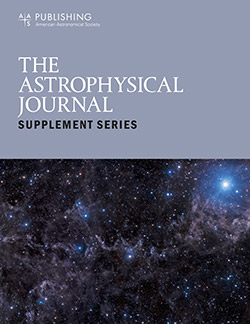Toward a Live Homogeneous Database of Solar Active Regions Based on SOHO/MDI and SDO/HMI Synoptic Magnetograms. I. Automatic Detection and Calibration
IF 8.5
1区 物理与天体物理
Q1 ASTRONOMY & ASTROPHYSICS
引用次数: 0
Abstract
Abstract Recent studies indicate that a small number of rogue solar active regions (ARs) may have a significant impact on the end-of-cycle polar field and the long-term behavior of solar activity. The impact of individual ARs can be qualified based on their magnetic field distribution. This motivates us to build a live homogeneous AR database in a series of papers. As the first of the series, we develop a method to automatically detect ARs from 1996 onward based on SOHO/MDI and SDO/HMI synoptic magnetograms. The method shows its advantages in excluding decayed ARs and unipolar regions and being compatible with any available synoptic magnetograms. The identified AR flux and area are calibrated based on the cotemporal SDO/HMI and SOHO/MDI data. The homogeneity and reliability of the database are further verified by comparing it with other relevant databases. We find that ARs with weaker flux have a weaker cycle dependence. Stronger ARs show a weaker cycle 24 compared with cycle 23. Several basic parameters, namely, the location, area, and flux of negative and positive polarities of the identified ARs, are provided in the paper. This paves the way for ARs’ new parameters quantifying the impact on the long-term behavior of solar activity to be presented in the subsequent paper of the series. The constantly updated database covering more than two full solar cycles will be beneficial for the understanding and prediction of the solar cycle. The database and the detection codes are accessible online.基于SOHO/MDI和SDO/HMI天气磁图的太阳活动区实时均匀数据库研究。1、自动检测和校准
近年来的研究表明,少量的太阳活动异常区(ARs)可能对太阳活动周期末的极场和太阳活动的长期行为产生重大影响。单个ar的影响可以根据它们的磁场分布来确定。这促使我们在一系列论文中构建一个实时的同构AR数据库。作为该系列的第一部分,我们开发了一种基于SOHO/MDI和SDO/HMI天气磁图的自1996年以来ARs自动检测方法。该方法在排除衰变氩和单极区以及与任何可用的天气磁图兼容方面具有优势。基于同时SDO/HMI和SOHO/MDI数据对识别出的AR通量和面积进行了标定。通过与其他相关数据库的对比,进一步验证了该数据库的同质性和可靠性。我们发现通量较弱的ar具有较弱的周期依赖性。较强的ar表现出较弱的第24周期。本文给出了几个基本参数,即所识别的ar的位置、面积和负极性和正极性的通量。这为ARs的新参数量化对太阳活动长期行为的影响铺平了道路,这些影响将在本系列的后续论文中提出。不断更新的涵盖两个以上完整太阳周期的数据库将有助于对太阳周期的认识和预测。数据库和检测代码可以在线访问。
本文章由计算机程序翻译,如有差异,请以英文原文为准。
求助全文
约1分钟内获得全文
求助全文
来源期刊

Astrophysical Journal Supplement Series
地学天文-天文与天体物理
CiteScore
14.50
自引率
5.70%
发文量
264
审稿时长
2 months
期刊介绍:
The Astrophysical Journal Supplement (ApJS) serves as an open-access journal that publishes significant articles featuring extensive data or calculations in the field of astrophysics. It also facilitates Special Issues, presenting thematically related papers simultaneously in a single volume.
 求助内容:
求助内容: 应助结果提醒方式:
应助结果提醒方式:


